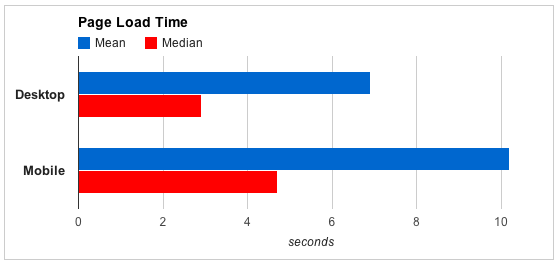About a year ago Google’s Matt Cutts published a Webmaster Central video affirming that site speed affects search results. In fact, Cutts noted that one in every 100 searches are influenced by lagging sites. Websites with a high volumes of custom content should see how their sites stack up to the U.S. average.
“As long as your browser isn’t timing out or being flaky, you should be in good shape,” Cutts said. “Typically, as long as just a few pages are slow or the site overall is fast, you should be OK.”
Since Cutts’ video, site speed has become a more important ranking signal, as a faster web is a strong web. To gauge search efficiency, Google recently conducted a study to obtain measurement data around the median and mean of desktop and mobile page load time, and insights will set parameters for brands optimizing their sites for search and user experience.
According to Google’s latest data, pages accessed on desktop computers take slightly less time to load than on mobile technology. The source found that the mean load time for desktops is 7 seconds and the median around 3 seconds. As for mobile phones and tablet computers, the mean is 10 seconds and median is 5 seconds.
 Google notes that various components can affect load speed – user network, device type and speed, geographic location and cache size. Website owners can review the speed of their sites in Google Analytics through the new Web Timing standard tab. This section allows brands to generate detailed reports on load time for various page samples, from dozens of dimensions. It’s important for SEO content writers to understand how different types of media influence load time.
Google notes that various components can affect load speed – user network, device type and speed, geographic location and cache size. Website owners can review the speed of their sites in Google Analytics through the new Web Timing standard tab. This section allows brands to generate detailed reports on load time for various page samples, from dozens of dimensions. It’s important for SEO content writers to understand how different types of media influence load time.
A website owner can gain a better understanding of her site’s load time by looking at the content hosted on her pages. For example, infographic marketing content can often take up a lot of space if not saved in the right file format. While quality is paramount to a better user experience, site owners should look at file size as a flexible component, because images can be saved at certain sizes without losing quality. More, site owners shouldn’t publish a several video files or big files on a single page if they want to provide visitors with fast load times.
In addition to offering SEO benefits, it’s clear that web users prefer sites that load quicker, and brands must continue to optimize their pages for the most efficient and effective experience. Brafton has reported some marketers find every second of load time drops conversions by 7 percent.




